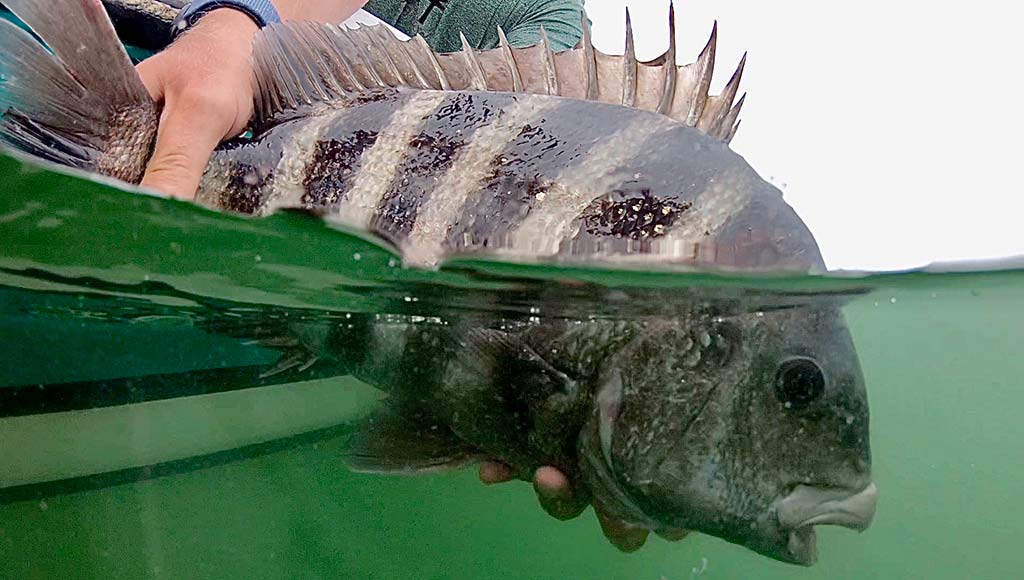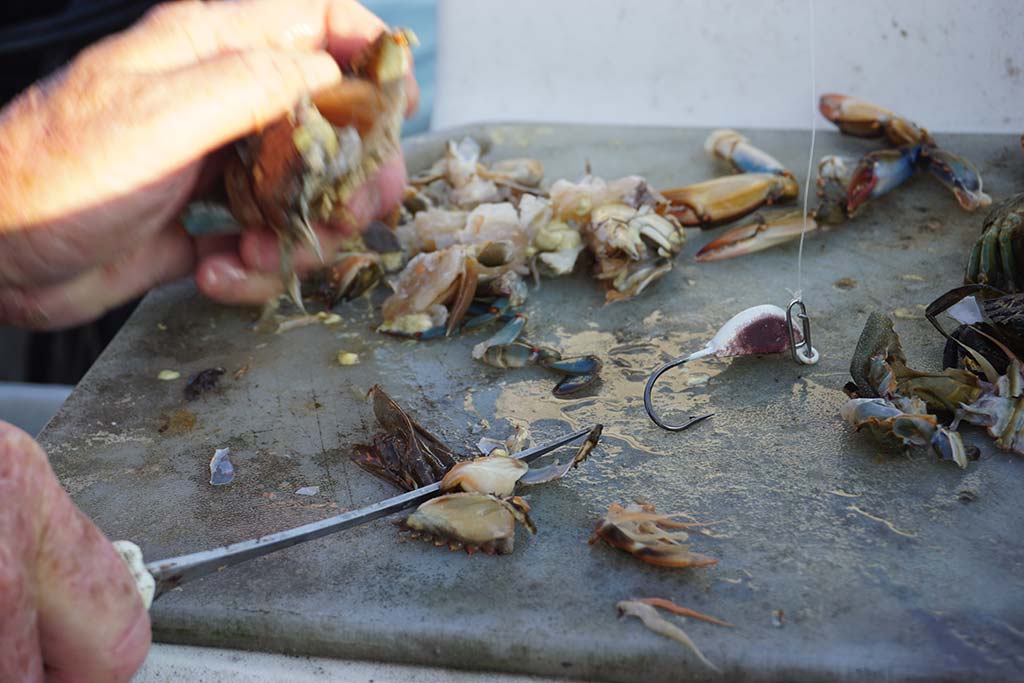
Climate change or historic returns; perhaps a bit of both!
From the South Jersey marshes in Tuckerton to the shores of Brooklyn in metropolitan New York, the proper name Sheepshead has often been considered some shapely reference to livestock than anything fish-related. Sure, I guess if you stare at a map long enough, the outline of New York City’s Sheepshead Bay might bear some “shot in the dark” resemblance to a sheep’s head, but topographically speaking there’s not much to be found in that answer along the winding waters of Little Sheepshead and Big Sheepshead creeks which meander through the Great Bay Boulevard Conservation Area in the Garden State.
A sheepshead resurgence of sorts in recent years has many folks clamoring about migratory shifts in a changing climate, which may in fact be a contributing factor. But to understand the historical past, present, and future of “sheepshead” in the New York, New Jersey region it may be equally as important to look into the “History on the Half Shell” which is the subtitle of the Mark Kurlansky book The Big Oyster.
Scourge Of Oystermen
The 2006 national bestseller by Kurlansky chronicles the history of the oyster in New York City going back to pre-colonial times, detailing the history of the oyster and its impact on Big Apple waters. “Oysters under normal conditions feed continually, and between 20 and 50 gallons of seawater are moved through a single oyster’s gills every day,” Kurlansky writes, while explaining how the original oyster population of New York Harbor was capable of filtering all of the water in the harbor in a matter of days.
Thus, in the Naming of Sheephead Bay, a blog entry by writer Nicole Davis in 2009 at the website brooklynbased.com noted that along with oysters, the sheepshead “once graced the plates of New York City’s finer dining establishments and populated its namesake bay off the eastern coast of Coney Island before mysteriously vanishing,” while describing the vertically-striped fish of boasting “a system of sharp front teeth and larger, rear grinding teeth allow sheepshead to crush oyster and clam shells, which are part of its omnivorous diet.”
That blog entry prompted me to purchase a book by John Waldman, professor of biology at the City College of New York located in Queens. Heartbeats in the Muck traces the history of the New York Harbor, in which Waldman cites historical documents indicating that several shellfish-loving species were more prevalent to local waters a century ago. “Black drum, absent for a century, was the scourge of the Staten Island oyster planters and were commonly caught around Manhattan to weights of seventy pounds, the Harlem River and the Battery being prime locations,” Waldman noted in his 1999 book, adding “sheepshead are no longer caught at Sheepshead Bay or anywhere else around New York City.”
Personally, journal references like these are as good as gold; like entries in an old fishing log, poring over citations in books and periodicals provide a method of understanding cycles or conditional factors which may contribute to a bite. The late, John Geiser from the Asbury Park Press for example published one of the quintessential guides to saltwater fishing in the region (Geiser’s Guide to Saltwater Fishing) in which he compiles tactical and scientific information on 77 species of fish found in the New York Bight region. Published in 2000 Geiser’s Guide incorporates six volumes of work by George Brown Goode of the U.S. National Museum of 1884. On sheepshead, Geiser noted, “from the late 1800s through the early 1900s the fish was abundant around Long Island and along the New Jersey coast to Cape May.”
Geiser also cited old U.S. Commission of Fish and Fisheries records as documenting an abundance of sheepshead around Wareham, MA in 1803, while noting how the species began disappearing from Narragansett Bay in Rhode Island around 1793. Cycles or exceptions? Either way, understanding the nature of the sheepshead can provide another opportunity at times when others think it’s not possible.
Research & Records
A member of the porgy family which is can weigh upwards of 20 pounds, the sheepshead fish is a regular target of fishermen in the Southeast and Gulf states. The IGFA world record which has stood fast for nearly 30 years came out of New Orleans, LA by way of a 21-pound, 4-ounce sheepshead for Wayne Desselle. More recently however, a few large specimens in New York and New Jersey have some anglers wondering if the next benchmark for greatness could fall to the north.
In September of 2020, James Torborg of Atlantic Beach, NY set a new state record there for a 13.9-pound sheepshead caught in Reynolds Channel, roughly 9 miles east of Sheepshead Bay. Meanwhile in South Jersey, William Catino was fishing at Longport in the fall of 2014 when he tied into a behemoth sheepshead from a local bulkhead that had taken one of the calico crabs collected earlier by his young daughters. That fish weighed in at 19 pounds, 3 ounces at Ray Scott’s Dock in Margate new Atlantic City. It eclipsed the previous state record taken by Paul Lowe of Manahawkin 10 years prior by a little more than 2 pounds; Lowe’s fish was taken on clam near the Causeway Bridge leading onto Long Beach Island.

In between the Lowe catch and the Catino catch lies a pair of winding creeks connecting Little Egg Harbor Bay and Great Bay in New Jersey called Little Sheepshead and Big Sheepshead. There is nothing to the shape of these “cricks” that would lend to a sheepish reference, but perhaps it’s more along the lines of rebounding oyster beds throughout the region.
So I guess it all depends on whether you see the glass as half-full or half-empty. The return of sizable sheepshead in New Jersey, New York waters can certainly be attributed to shifting migration patterns resulting from climate change; but it may also be a result of the reintroduction of shellfish beds and the actual conservation principles in place in the United States over the past 50 years.
Like a lot of kids in who grew up at the Jersey Shore in the previous millennium, I dug clams most every summer, selling my catch to local wholesalers for roughly 10 cents apiece. On a good day, I could make $100 in a five-hour tidal shift, leaving plenty of time to fish or surf while buddies were toiling away at other summer jobs. It was during those early days when local old timers relayed tales of how they rid their shellfish beds of nuisance predators, namely the cow-nosed rays, black drum, and no doubt sheepshead, all of which could make quick work in devouring a plot of clams or oysters.
The method? As the stories go, a stick of dynamite would do the trick.
Try & You May Succeed
Whether or not tales of this explosive method of “fisheries management” are completely accurate, this “scourge of the Staten Island oyster planters” is built with tools – namely sheep-like teeth – enabling the sheepshead to crush mollusks and crustaceans to get to the juicy filling. This makes sense along some of the mussel and coral beds where I’ve encountered a few myself in the past few years, and especially why old docks and bridge pilings which have become prime locations for picking off sheepshead in southern New Jersey and Delaware.
McClane’s Fishing Encyclopedia says “the sheepshead is a very suspicious quarry and when located the experienced angler frequently chums the area with crushed fiddler crabs to stir them into feeding,” while noting “fiddler crabs, hermit crabs, shrimp and sandbugs are popular baits.” Equally good are blue claw or shedder crab, and prime tautog baits like the green crab or white legger.
I know calicos will entice a bite or two as well, especially closer to the inlets where those baits may be more prevalent. Throughout much of South Jersey’s back bays where sheepshead have become more of a popular target in recent years, it does seem the fiddler crab is taking over as one of the top baits.
Prospecting for sheepshead is made exceptionally easier with a trolling motor. A few minutes spent on an old rubble pile, shellfish bed, next to dockside pilings or coastal bridge base is made much simpler with the quick deployment of a Minn Kota and a few touches of the hand-held unit to move along 5 feet at a clip in any direction. Personally, I’ve found better success at slack tide when the current is at its weakest. If you think about it, since sheepshead aren’t typically chasing down live baits but picking away crabs or barnacles, that hour or so of around the top or bottom of the tide offers a good window for a tactical attempt.

And tactically, the technique is pretty much the same as tautog jigging (you’ll find scores of editorial on tautog jigs or blackfish jigging at TheFisherman.com) though I find sheepshead “bites” even more difficult to process than tautog. Capt. Dan Schafer of Insomniac Guide Service out of Stone Harbor, NJ has become probably the most well-known sheepshead angler/guide in the entire region, focusing extensive effort and research into this unique fishery. Picking his brain every year at the Atlantic City Boat Show with a new question or two has provided a few new wrinkles.
For example, Capt. Schafer has told me that being off your mark even a few inches will lead you to believe there’s no one home on the structure you’re fishing. And while one particular spot I fish leads me to keep my jighead at or near the bottom, when Insomniac charters are targeting sheepshead along bridge pilings, they’ll present baits at various depths along the vertical structure.
After years of targeting this species and fine-tuning his tactics, Capt. Schafer put out a line of crab jigs called Bottom Sweeper Jigs which are tailor-made for fishing for sheepshead, as well as tautog. It was Shafer who once told me that he begins to target sheepshead in southern New Jersey not long after black drum arrive. I’ve personally found that working over a small patch of living coral off the marshes – not far from the creeks named Sheepshead in late summer – that black drum, tog and triggerfish have produced some fine bycatch to my sheepshead expeditions.
If you find tautog jigging a sometimes frustrating experience, you’ll find more of the same with sheepshead (especially if you’re not even sure they’re in the neighborhood to begin with). But while fluking with friends on Jamaica Bay in years past, or cruising by the rocky lighthouses (or what’s left of them) along the Raritan Bay, I just can’t help but wonder why more folks haven’t hit the Spot Lock on their Minn Kota to give a tautog jig (S&S White Chin Wrecker, MagicTail Tog Jig, Tsunami Tog Treat, Intent Tackle Structure Series, Bottom Sweeper, et al) with crab a shot when the tide is right and the summer visitors are still around!




